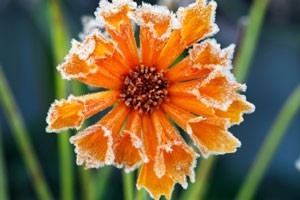
Every growing zone has an average number of frost free days-days between the last frost in the spring and the first frost in the fall. These frost-free days are our growing season. Our chance to nurture flowers, vegetables, and fruit to maturity. For gardeners living in the coldest zones, the threat of frost never completely goes away. For gardeners living in the warmest zones, the threat of frost sometimes never comes. For the rest of us, it's a bit of a guessing game.
Most of us are familiar with the USDA Plant Hardiness Zone maps that show the average minimum temperature for a given area. Unfortunately, when it comes to figuring out what are average first and last frost dates, the information isn't as clear. No one accurate and concise source exists. Depending on the source, the frost dates given for an area can vary wildey-in some cases by as much as a month or more. All are given in approximates. Climate change and outdated data only adds to the confusion. In some parts of the country, it's as though someone has taken a dial and spun the seasons forward. Spring and fall both seem to be arriving a bit later.
Here are three of the best resources for finding your frost dates:
Farmer's Almanac.Average frost dates
Your Cooperative Extension Agency. Most county extension agencies have a gardening and horticulture department staffed with volunteer Master Gardeners adept at answering local gardening questions. If they can't answer your question, contact the meteorologist at your local TV or radio station.
You! None of the above maps or experts knows your garden better than you do. If don't already keep a garden journal, it might be helpful to start one even if it's only notes about the weather. Remember, frost dates are always given in approximates. They cannot take into account microclimates-things like elevation, exposure, large trees, large bodies of water, or large buildings. All of these factors can affect frost.
The difference between a frost and freeze is pretty simple in gardening terms. Frost occurs when water vapor freezes on a surface at 32 degrees F. A freeze occurs when a surface temperature of 32 degrees F or less lasts for a significant length of time (frost need not be present for a freeze to occur). A HARD frost is usually considered when frost occurs below 28 degrees F, a temperature that causes significant injury (or death) to most tender plants.
If you notice a plant suffering from frost damage, the best thing you can do is to be patient. If the plant looks salvageable, continue to protect it from frost, but leave it alone until you see signs of new growth. Once new growth starts, the point at which the freeze damage occurred will be clearly defined and make removing damaged leaves and stems easy.

About The Author: Ellen Brown is an environmental writer and photographer and the owner of Sustainable Media, an environmental media company that specializes in helping businesses and organizations promote eco-friendly products and services.
Add your voice! Click below to comment. ThriftyFun is powered by your wisdom!